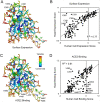This is a preprint.
An engineered decoy receptor for SARS-CoV-2 broadly binds protein S sequence variants
- PMID: 33398275
- PMCID: PMC7781310
- DOI: 10.1101/2020.10.18.344622
An engineered decoy receptor for SARS-CoV-2 broadly binds protein S sequence variants
Update in
-
An engineered decoy receptor for SARS-CoV-2 broadly binds protein S sequence variants.Sci Adv. 2021 Feb 17;7(8):eabf1738. doi: 10.1126/sciadv.abf1738. Print 2021 Feb. Sci Adv. 2021. PMID: 33597251 Free PMC article.
Abstract
The spike S of SARS-CoV-2 recognizes ACE2 on the host cell membrane to initiate entry. Soluble decoy receptors, in which the ACE2 ectodomain is engineered to block S with high affinity, potently neutralize infection and, due to close similarity with the natural receptor, hold out the promise of being broadly active against virus variants without opportunity for escape. Here, we directly test this hypothesis. We find an engineered decoy receptor, sACE2 2 .v2.4, tightly binds S of SARS-associated viruses from humans and bats, despite the ACE2-binding surface being a region of high diversity. Saturation mutagenesis of the receptor-binding domain (RBD) followed by in vitro selection, with wild type ACE2 and the engineered decoy competing for binding sites, failed to find S mutants that discriminate in favor of the wild type receptor. Variant N501Y in the RBD, which has emerged in a rapidly spreading lineage (B.1.1.7) in England, enhances affinity for wild type ACE2 20-fold but remains tightly bound to engineered sACE22.v2.4. We conclude that resistance to engineered decoys will be rare and that decoys may be active against future outbreaks of SARS-associated betacoronaviruses.
Figures





References
Publication types
Grants and funding
LinkOut - more resources
Full Text Sources
Molecular Biology Databases
Miscellaneous
